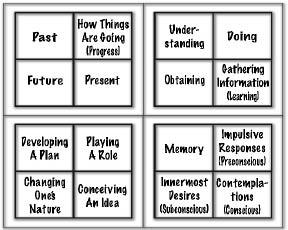Types
At this point, we have achieved a clearer understanding of our story's theme by classifying the story's problem. In our own lives, however, this would be insufficient information to identify the problem clearly enough to begin solving it. The same is true of the Story Mind. We need to dig deeper and be more precise if eventually we are to pinpoint the source of the story's problem so it can be addressed at the root.
To increase our precision, we can subdivide each of the Classes into different TYPES of problems within each Class, much as the classification "animal" and "vegetable" subdivide into various species.
Situation Types Activity Types

Manipulation Types Fixed Attitude Types
Types
As you can see, the TYPE level of resolution on our story's problem is much more refined. Already the names of the Types carry much more of a thematic feel than those of the broad-stroke Classes. Some of the Types seem more familiar than others. This is because our culture has its own built-in biases and favorites and tends to focus on certain kinds of problems more than others.
If we compare the Types in one Class to those in the others, we can see how the chart does not cater to our culture's biases. Rather, it presents a neutral set of subcategories so any problem an author might wish to address is treated with equal weight.
One of the first things we can begin to feel about the Types is that their position within each quad has an influence on the nature of the Type, which is reflected in its name. For example, in the upper left hand corner of the Situation Class we find the Type, "Past." By comparison, in the upper left hand corner of the Fixed Attitude Class we find the Type, "Memory." The balance of the chart can be easily illustrated in the phrase, "Past is to Situation as Memory is to Fixed Attitude." In fact, all the categories and subcategories we have explored (and the two remaining levels) share this relationship.
We have found that it helps to get a feel for a story's problem by running this kind of comparison over in our minds as we examine the chart. Patterns of relationships begin to emerge, and the process of choosing the Class and Type of problem at the heart of our story's theme becomes almost a game.
